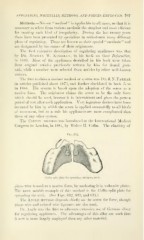Page 709 - My FlipBook
P. 709
APPLIANCES, MATERIALS, METHODS, AND FORCES EMPLOYED. 707
Methods.—Xo one '^ method " is applicable to all cases, so that it is
necessary to select from various methods the simj)lest and most efficient
for treating each kind of irregularity. During the last twenty years
there have been presented by specialists in orthodontia many different
plans of regulating. These are known as tlieir special "methods" and
are designated by the names of their originators.
The first extensive description of regulating appliances was that
by Dr. Noemax W. Kixgsley, in his book on Oral Deformities,
in 1880. Most of the appliances described in his book were taken
from original articles previously written by him for dental jour-
nals, while a number were selected from articles by other well-known
writers.
The first to claim a distinct method or system was Dr. J. N. Farrar
in articles published about 1875, and further elucidated in book form
in 1888. His system is based upon the adoption of the screw as a
motive force. The originator claims the screw to be the only force
which should be used, because it is intermittent and gives the parts a
period of rest after each application. Very ingenious devices have been
invented by him by wliich the screw is applied successfully to all kinds
of movement, but as a rule his appliances are more complicated than
those of any other system.
The Coffin method was introduced at the International Medical
Congress in London, in 1881, by Walter H. Coffin. The elasticity of
Fk;. fi.'^-J.
Cofliu split plate for spreading the upper arch.
piano wire is used as a motive force, by anchoring it in vulcanite plates.
The most notable exam])le of this method is the Coffin split plate for
spreading the arch. (See Figs. 632, 633, and 634.)
The Angle method depends chiefly on the screw for force, though
piano wire and twisted wire ligatures are also used.
Dr. Angle M'as the first to advocate extensive use of German silver
for regulating appliances. The advantages of this alloy are such that
it now is more largely employed than any other material.


